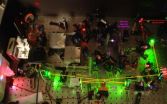(Press-News.org) INDIANAPOLIS -- A new study shows that a practical clinical tool developed by researchers from the Regenstrief Institute and the Indiana University School of Medicine to measure severity of dementia symptoms is reliable and valid. The Healthy Aging Brain Care Monitor is simple, user-friendly and sensitive to change in symptoms.
"The HABC Monitor is a 'blood pressure cuff' for dementia," said Regenstrief Institute investigator Malaz Boustani, M.D., MPH, associate professor of medicine and associate director of the IU Center for Aging Research. A geriatrician, Dr. Boustani is the study's corresponding author and principal investigator. He is also medical director of the Healthy Aging Brain Center at Wishard Health Services, the public hospital where the study was conducted. "Much as doctors and nurses use a sphygmomanometer -- a blood pressure cuff -- to quickly and repeatedly determine changes in blood pressure, we have developed a 31-item questionnaire to easily measure and track dementia symptoms. The results provide information critical to the clinician's care of older adults as well as to caregiver's well-being."
Divided into clinically relevant domains -- cognitive, functional, and behavioral and psychological symptoms of the patient; and caregiver quality of life -- all questions on the HABC Monitor have the same response options, ranging from never to almost all days. It takes about six minutes for caregiver response.
In the study, 171 caregivers -- three-quarters of whom were female -- completed the HABC Monitor. Fifty-two percent of the caregivers were the children of the patients, 34 percent were spouses, 6 percent were siblings, and 4 percent were grandchildren. Caregivers had a mean age of 58 years. Ninety percent indicated that they knew the patient very well, while 10 percent indicated they knew the patient well.
"We found the HABC Monitor to be highly sensitive to changes in the patient, both declines and improvement," said Patrick Monahan, Ph.D., associate professor of biostatistics at the IU School of Medicine. He is a psychometrician and first author of the new study. "The HABC Monitor is also able to distinguish between groups of patients who differ in severity of impairment based on physician diagnoses and based on other questionnaires that have been validated for research but are too long and time-consuming for clinical practice.
"Depression and anxiety, both very common in older adults with dementia, but often missed during a busy office visit, are highlighted for the clinician. This study confirmed that the HABC Monitor is an accurate measure of dementia symptoms. We are seeking funding to study the impact of this new 'blood pressure cuff' on primary care, where most older adults receive their care."
"A Practical Clinical Tool to Monitor Dementia Symptoms: The HABC-Monitor" was published June 14 in Clinical Interventions in Aging, an international peer-reviewed open-access publication.
INFORMATION:
Co-authors in addition to Drs. Monahan and Boustani are Catherine Alder, MSW, of the Regenstrief Institute and the IU Center for Aging Research; James E. Galvin, M.D., MPH, of the New York University School of Medicine; Anthony J. Perkins, M.S., of the IU Center for Aging Research; Patrick Healey, M.D., of the St. Vincent Health; Azita Chehresa, M.D., Ph.D. of Community Health Network; Polly Shepard, Ph.D., and Corby Bubp, Ph.D., of the Memory Clinic of Indianapolis; Amie Frame, MPH, of the Regenstrief Institute and the IU Center for Aging Research; and Christopher Callahan, M.D., of the Regenstrief Institute, IU Center for Aging Research and IU School of Medicine. Alder and Drs. Boustani and Callahan see patients at the Healthy Aging Brain Center at Wishard.
This work was funded by grants from National Institute on Aging (P30AG024967), National Institute of Mental Health (R24MH080827) and Agency for Healthcare Research and Quality (R01 HS019818-01).
The HABC-Monitor is a copyrighted by Drs. Boustani, Galvin and Callahan and the IU School of Medicine. The HABC Monitor and scoring rules are available without charge online at http://www.indydiscoverynetwork.org/HealthyAgingBrainCareMonitor.html.
Study: Free, user-friendly 'blood pressure cuff' for dementia is reliable and valid
2012-06-15
ELSE PRESS RELEASES FROM THIS DATE:
Study shows pollution levels in some kitchens are higher than city-center hotspots
2012-06-15
Researchers from the University of Sheffield's Faculty of Engineering measured air quality inside and outside three residential buildings with different types of energy use (gas vs. electric cookers). They found that nitrogen dioxide (NO2) levels in the kitchen of the city-centre flat with a gas cooker were three times higher than the concentrations measured outside the property and well above those recommended in UK Indoor Air Quality Guidance (1). These findings are published online in Journal of Indoor and Built Environment (2).
"We spend 90 per cent of our time indoors ...
2 warmest winter months in Midwest history may have connection
2012-06-15
COLUMBIA, Mo. – This past March was the second warmest winter month ever recorded in the Midwest, with temperatures 15 degrees above average. The only other winter month that was warmer was December of 1889, during which temperatures were 18 degrees above average. Now, MU researchers may have discovered why the weather patterns during these two winter months, separated by 123 years, were so similar. The answer could help scientists develop more accurate weather prediction models.
Tony Lupo, chair of the Department of Soil, Environment and Atmospheric Sciences in the ...
New action for ancient heart drug
2012-06-15
An ancient heart drug that's inspired the work of herbalists and poets for centuries may treat a condition that plagues millions of overstressed and overweight Americans today.
Since the 13th century, the herb Foxglove has been used to cleanse wounds and its dried leaves were brewed by Native Americans to treat leg swelling caused by heart problems.
In an article published online today in Molecular Pharmacology, researchers at the University of Michigan Health System reveal that digoxin, the active ingredient in digitalis, or Foxglove, can enhance the body's own protective ...
Link between metabolic disorders and Alzheimer's disease examined
2012-06-15
Amsterdam, NL, June 14, 2012 – No effective treatments are currently available for the prevention or cure of Alzheimer's disease (AD), the most frequent form of dementia in the elderly. The most recognized risk factors, advancing age and having the apolipoprotein E Ɛ4 gene, cannot be modified or treated. Increasingly, scientists are looking toward other risk factors to identify preventive and therapeutic strategies. Much attention recently has focused on the metabolic syndrome (MetS), with a strong and growing body of research suggesting that metabolic disorders ...
Fragile X gene's prevalence suggests broader health risk
2012-06-15
MADISON – The first U.S. population prevalence study of mutations in the gene that causes fragile X syndrome, the most common inherited form of intellectual disability, suggests the mutation in the gene – and its associated health risks – may be more common than previously believed.
Writing this month (June 2012) in the American Journal of Medical Genetics, a team of Wisconsin researchers reports that the cascade of genetic amino acid repeats, which accumulate over generations and culminate in the mutation of a single gene causing fragile X, is occurring with more frequency ...
Scientists sequence genome of human relative that prefers love over war
2012-06-15
COLUMBUS, Ohio – An international team of scientists has sequenced the genome of the bonobo, a primate that, along with chimpanzees, is the closest living relative of humans. Unlike chimpanzees, which have an aggressive nature, bonobos tend to be peaceful, playful and highly sexual.
The study, published online in the journal Nature, compares the bonobo genome to the genomes of chimpanzees and humans.
As part of the study, scientists at the Ohio State University Comprehensive Cancer Center – Arthur G. James Cancer Hospital and Richard J. Solove Research Institute (OSUCCC ...
JILA frequency comb helps evaluate novel biomedical decontamination method
2012-06-15
Like many new measurement tools, the laser frequency comb seemed at first a curiosity but has found more practical uses than originally imagined. The technique for making extraordinarily precise measurements of frequency has now moved beyond physics and optics to advance biomedicine by helping researchers evaluate a novel instrument that kills harmful bacteria without the use of liquid chemicals or high temperatures.
Generated by ultrafast lasers, frequency combs precisely measure individual frequencies (colors) of light. Researchers at JILA, operated jointly by the ...
Single-track sustainability 'solutions' threaten people and planet
2012-06-15
The targets, indicators and approaches being used to pursue progress towards sustainable development at Rio+20 are counter-productive, say scientists in a new paper.
Goals focussing on one-track scientific solutions to the most urgent sustainability problems fail to respond to the uncertainty and shifting dynamics of today's world. These one-direction approaches risk breaching the already weakened planetary boundaries which define a safe operating space for humanity, while undoing past progress on global poverty reduction.
Instead, sustainable futures should be plotted ...
For future prosperity, US should strengthen efforts to maintain world-class research universities
2012-06-15
WASHINGTON — American research universities are essential for U.S. prosperity and security, but the institutions are in danger of serious decline unless the federal government, states, and industry take action to ensure adequate, stable funding in the next decade, says a new report by the National Research Council, the operating arm of the National Academy of Sciences and National Academy of Engineering. As trusted stewards of public funds, universities must also meet "bold goals" to contain costs, enhance productivity, and improve educational pathways to careers both ...
Green grabs: The dark side of the green economy
2012-06-15
'Green grabbing' - the rapidly-growing appropriation of land and resources in the name of 'green ' biofuels, carbon offsetting schemes, conservation efforts and eco-tourism initiatives – is forcing people from their homelands and increasing poverty, new research has found.
Ecosystems being 'asset-stripped' for profit is likely to cause dispossession and further poverty amongst already-poor land and resource users, according to a set of 17 new research case studies from Africa, Asia and Latin America, published in a special issue of the Journal of Peasant Studies.
"Green ...



